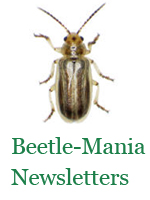 Carduus nutans L.
Carduus nutans L.
[Asteraceae]
Other common names: nodding thistle
Scientific name status: This thistle is sometimes referred to as a complex of species. Carduus macrocephalus is sometimes used for the same plant or as a subspecies.
Musk thistles are annuals, winter annuals, or biennials. In Texas, seeds produced in summer germinate to form young rosettes in the fall. The rosettes overwinter and resume development in the spring. Stems elongate from March to April and the plant typically flowers in April and May. Determinate blooming continues through June, with seeds dropping in June and July. A wide range of growth habits, plant heights, and plant densities are possible primarily in response to local moisture levels.
(Top)
Musk thistle was introduced from Eurasia in about 1853, and is now found in more than 40 states. It was first reported in Texas by Cory (1940). Musk thistle has become a problem weed in several counties in the Texas Hill country. It also occurs locally in the Panhandle, Central Texas, and North Texas.
(Top)
Musk thistle is a noxious weed in pastures, rangeland, cropland, along highways, and even in many urban areas of the U.S. This thistle is successful for many reasons such as: it produces a large number of seeds, the seeds have a long life, the plant competes well with other plants and there are few natural enemies in this country. Consequently, it continues to thrive and expand its range in Texas.
(Top)
Musk thistle can be controlled mechanically, chemically with herbicides, and biologically using natural enemies that feed on the plant. Mechanical methods consisting mainly of mowing and hoeing are expensive. Musk thistle has long been controlled effectively with herbicides. However, chemical control is not usually permanent and is also expensive when repeated every year.
The advantages of biological control program are:
- It is inexpensive
- It poses little threat to non-target organisms
- Once established, natural enemies move into adjoining infested areas
- Little additional effort is required once a natural enemy is established, while other controls must be applied periodically
- It does not threaten water quality, even along streams.
(Top)
- Thistle head weevil, Rhinocyllus conicus
- Musk thistle rosette weevil, Trichosirocalus horridus
- Musk thistle flower fly, Cheilosia corydon
- Musk thistle leaf beetle, Psylliodes chalcomera
(Top)
Boldt, P. E., and J. A. Jackman. 1993. Establishment of Rhinocyllus conicus Froelich on Carduus macrocephalus in Texas. Southwestern Entomologist 18(3): 173-181.
Cory, V. L. 1940. Six thistles recently introduced into Texas. Madrono 5: 200-201.
Jackman, J. A., P. Boldt, J. W. Stewart and T. W. Fuchs. 1992. Biological Control of Musk Thistle in Texas. L-5067. Biological Pest Control. Texas Agricultural Extension Service. Texas A&M University System, College Station, TX.
(Top)

